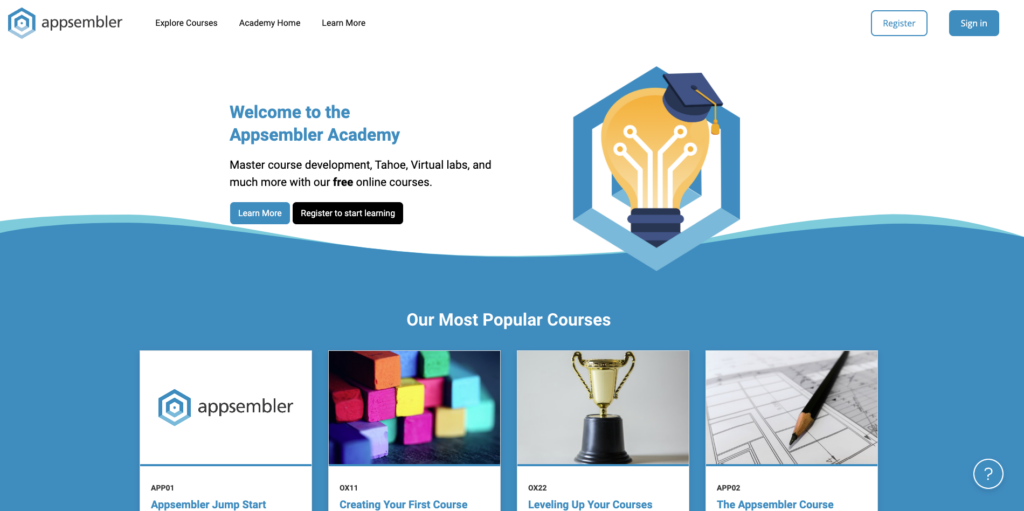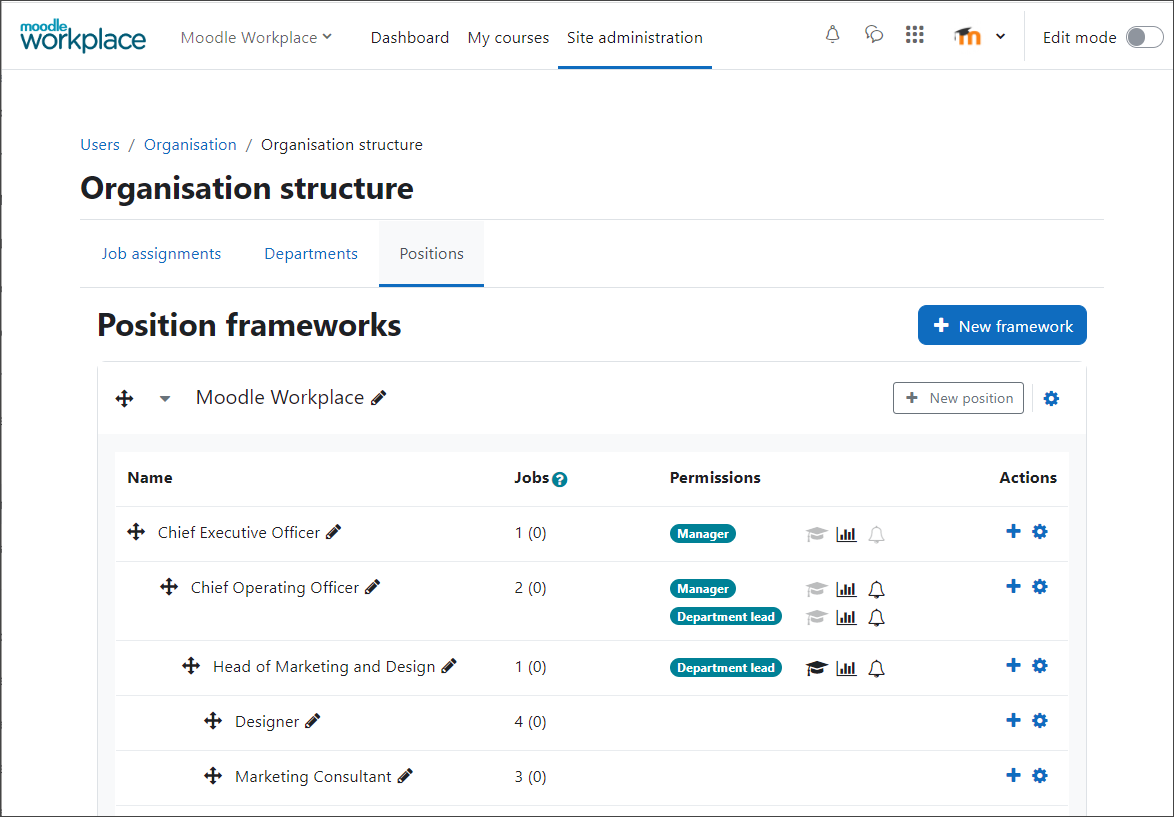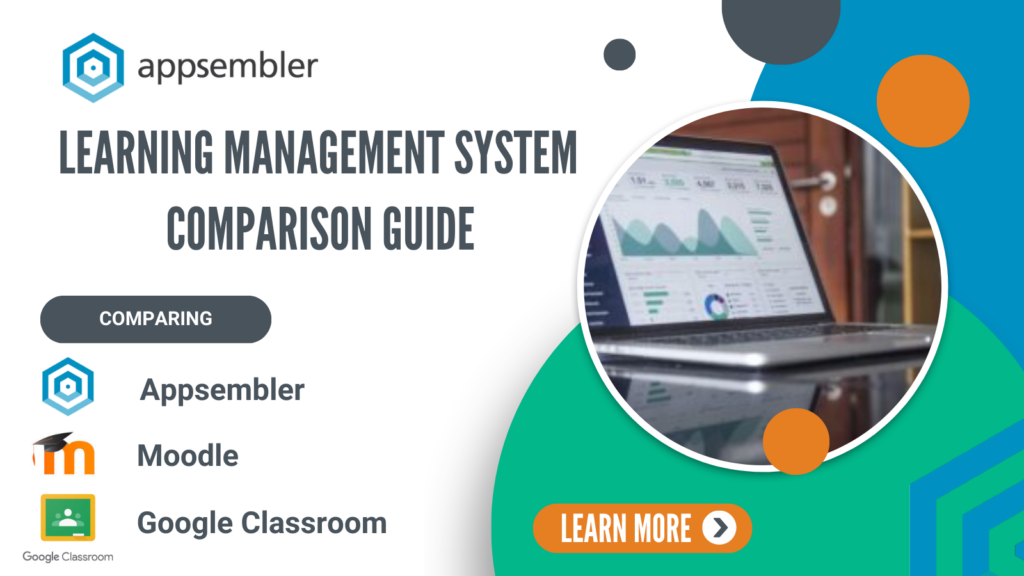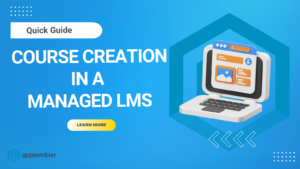The e-learning market was valued at USD 399.3 billion in 2022 and will grow at 14% CAGR between 2023 and 2032. Because of this, we see an increasing demand for immersive online learning and hands-on training, and along with it, the growth of learning management systems (LMS).
The big question that training managers want to know: With the abundance of LMS platforms, which one should you use?
In this article, we’ll compare three leading LMS platforms – Moodle, Google Classroom, and Appsembler – to help you choose the best one for your organization. Let’s dive in and find out how these LMS platforms stack up in terms of their features, integration, and pricing.
Key takeaways:
- Having comprehensive integrations offered by your LMS is crucial for educators and training managers who typically oversee a learning experience that extends across multiple technologies.
- Be wary of platforms that require technical knowledge for setting up and maintaining your LMS. Choosing an LMS with dedicated customer support can save you a lot of time and headaches.
- Look for transparency in your chosen LMS platform’s pricing model. Usage-based pricing can appear attractive at first but can become a financial strain as you scale.
- An online learning experience can’t be improved if it can’t be measured. Be sure to examine the analytics features of the LMS platforms you evaluate.
Overview: Moodle vs. Google Classroom vs. Appsembler
Appsembler | Moodle | Google Classroom | |
G2 Rating | 4.9 | 4.1 | 4.5 |
Key Features | LMS built on Open edX with integrated virtual labs Easy theme customizations & branding Worry-free hosting Powerful analytics to measure ROI | In-video conferencing Plugins and workflows Collaboration tools | Options for student-led enrollment via code or link Options to manage multiple courses Video meetings for synchronous sessionsMobile app |
Analytics | Real-time monitoring to track performance metrics like learner engagement & course completion rates | Analytics focus on the descriptive data Third-party plugins and Moodle Certified integrations for additional analytics Predictive analytics through the Learning Analytics API | Analytics available in Premium and coming soon |
Integrations | Pre-built and out-of-the-box integrations Powerful API endpoints for custom integrations along with SSO, LTI, and the Business Intelligence Connector | Vast integrations and plugin ecosystem 2000+plugins available Lack integrations with social media | Google ecosystem Non-Google integrations on add-ons, app licensing, SIS catering more for the academe |
Ease of Use | Instant use; no need for complex, time-consuming configuration Customizable branding & training certificationsResponsive design for both mobile and desktop accessibility Dedicated customer success and support team regardless of pricing plan | Flexible and easy to code Moodle Workplace create programs and bundles Excellent support team | Web browser tricker to use than mobile app Lack of search functionality Consumes a lot of mobile data |
Pricing | Transparent, with zero hidden fees: $520/mo. Starter Plan $1,265/mo. Pro Plan $2,625/mo. Premium Plan | Five plans are available, from $120 annually (50 users, 250 MB storage) to $1,670 annually (1,000 users, 5 GB). | Need to call the Sales team for pricing |
What Is Appsembler?

Tahoe LMS by Appsembler is a SaaS platform that offers a streamlined and simpler way to deliver learner-centric online learning.
Tahoe LMS is driven by Open edX, the open-source learning platform established by edX, MIT, and Harvard, catering to over 35 million learners. It empowers you to build a customized and branded LMS platform and deliver courses on a large scale.
Users include several global companies, including Redis, Snowflake, Cybereason, JFrog, InterSystems, and Starbucks.
What is Moodle?

Rating: 4.1/5.0 (G2)
Moodle is short-form for “Modular Object-Oriented Dynamic Learning Environment” and is known for its open-source LMS platform.
As the (long) name suggests, its modular-based design provides educators and learning managers a canvas to design, customize, and deliver their e-learning programs. Various plug-ins make it easier for them to build customized workflows and content.
With both on-premise and cloud-based deployment, Moodle provides users flexibility in the method and delivery of the learning content.
What Is Google Classroom?
Rating: 4.5/5.0 (G2)
Google Classroom was originally made for schools, especially around carrying out and monitoring students’ assignments and assessments. Even how Google describes this product on its landing page revolves around this use case.
While it’s still used heavily in the academic setting, this platform can be used across industries—practically anyone with a Gmail account. If you have a digital course or a consulting business looking for a free and intuitive way to engage with your clients, Google Classroom is a clear option for you.
If you’re already familiar with Google products’ interface, this platform is no different—it’s minimalist and simple.
Key Features Comparison
Moodle, Google Classroom, and Appsembler are all user-friendly and easy to use. While they have similar features, each excels in one or more areas.
Let’s dive deep into how each LMS sets itself apart and understand how its unique features could match your organization’s needs.
Appsembler
Tahoe LMS is powered by Open edX, the open-source learning platform, so upgrades and new content are continuously added.
Users of Tahoe LMS rave about the slick UI, instant onboarding, and branded site pages.
- Blended learning: Appsembler enhances the online component of blended learning through multimedia content integration, interactive assessments, and collaboration tools. You can also make use of Virtual Labs for hands-on training.
- Easy branding: Tahoe LMS provides a training platform that lets you use your brand’s logo, fonts, and colors and own custom domains, branded URLs, and Single Sign-on (SSO).
- Worry-free hosting: Tahoe handles the hosting, management, and maintenance so that you can focus solely on course creation. This LMS taps into the power of the learner-centric Open edX platform without worrying about the challenges associated with hosting Open edX.
Moodle
Like Appsembler, Moodle is also an open-source platform with a modular design, making it easy for course builders to customize their content, activities, and workflows.
Moodle also provides flexibility in terms of delivery—you can use it as a cloud-based platform (MoodleCloud) or install it into your server as an on-premise tool.
While other LMS focus on immersive experience, Moodle is about customization and collaboration.
- In-video conferencing: BigBlueButton paves the way for virtual classes and meetings, complete with audio and video sharing, whiteboard, and breakout rooms.
- Plugins and workflows: Create personalized learning paths and workflows using Moodle’s plugins
- Collaboration tools: Roll out peer reviews through Workshop and allow learners to publish articles on Blogs. Enable forum discussions, direct messages, calendars, and notifications among students and teachers.
Google Classroom
Google Classroom is an LMS that focuses on immersive experiences. It also allows teachers to upload content (such as videos, images, PDFs, and audio) and access templates and scheduling features.
- Options for student-led enrollment via code or link: Students can click the invite link to join, or enter through an email invite or class code.
- Options to manage multiple courses with different parameters: Instructors can switch to a different course, change the class details (i.e., class name), and select settings (how posts appear on the Stream page).
- Video meetings for synchronous sessions: Educators can host and record classes via Google Meet, with the basic Google account accommodating up to 100 participants per session. It can integrate with Zoom but not Microsft Teams (Moodle does alongside BigBlueButton).
- Access course content for users and administrators on mobile app: Users can access the platform through Apple or Android devices.
Analytics Comparison
In LMS, analytics should be easily accessible and easy to digest so organizations can gauge the effectiveness of the course and monitor learners’ progress. Let’s delve into how each of the three platforms makes this possible.
Appsembler
Appsembler provides in-depth analytics and real-time insights into the performance and progress of each person partaking in a training program or product demo.
Figures is an open-source application for Open edX users that lets you easily view the performance of your courses and students. Figures is a core analytics feature in Appsembler that monitors the number of course views, percentage of viewers fully or partially completing courses, and more.
With the data at hand, you can identify which courses are engaging and valuable for learners.
Moodle
While Moodle provides various built-in reports, it focuses on the descriptive aspects of log data—telling the “who,” “when” and “what,” not the “why” or “how well.” Users would typically look for the latter.
Moodle LMS core offers three analytics models:
- “Students at risk of dropping out”
- “Upcoming activities due”
- “No teaching”
Other models can be added to the system by installing third-party plugins and Moodle Certified Integrations.
Moodle also enables predictive analytics through its Learning Analytics API, an open system that leverages models containing indicators/predictors, targets, predictive insights, and actions.
Google Classroom
Classified under “Premium features,” Classroom analytics provide insights into the learning journey and outcomes—class performance to individual student assignment completion. This feature, however, is not yet available (though “coming soon.”)
As a data processing analyst who’s left a verified review on G2 puts it:
“I feel the product should work on implementing user performance and calculating by any analytics feature.”
You can also export Classroom logs to BigQuery to analyze adoption, engagement, and more.
Integrations Comparison
An LMS is only as good as its integrations. Discover what Appsembler, Moodle, and Google Classroom can seamlessly integrate into your existing workflow and where they fall short.
Appsembler
Appsembler offers multiple pre-built integrations, including a Zoom integration for communication, Analytics, and SCORM for auto-grading.
The robust integration capabilities empower you to integrate the LMS into your organization’s existing tech stack and ecosystem seamlessly. Instead of having a stand-alone LMS, you can streamline your learning journey, workflow, and operations as you integrate resource management, employee learning, etc.
Even if your system isn’t listed on Appsembler’s integration list, you can still add it. Leverage Appsembler’s APIs, SSO, LTI, or Business Intelligence Connector to integrate with your workflows and enterprise systems effortlessly.
You can handle the integration yourself or let Appsembler’s professional services team do it.
Moodle
Moodle’s strength lies in its vast integrations and plugin ecosystem.
From gamification modules to advanced reporting tools, Moodle’s repository houses over 2,000 plugins. This modular architecture allows learning technologists and educators to build a customized course and learning workflow for their learners.
However, some users are also looking for integrations with social media.
Google Classroom
Several users opt for Google Classroom because it integrates seamlessly with all other apps in the Google suite (except for Google Calendar, which could have been useful in setting deadlines).
Because it’s part of the Google ecosystem, users can also use Google Docs, Sheets, Slides, and Forms and collaborate within each app in real-time.
It also offers non-Google integrations, with options for add-ons, app licensing, and SIS integration. These integrations cover from collaborative doodling, video editing, and design (like Squid, LumaFusion, and Figma) to grade passback and student data aggregation (like Infinite Campus and Follett Aspen).
However, these integrations appear to cater more to the academe. There are limited apps available for other industries and corporate learning.
Ease of Use Comparison
An easy-to-use platform saves an organization’s resources while increasing learner uptake and engagement. Here’s how each platform fare in terms of user-friendliness.
Appsembler
Tahoe LMS is Appsembler’s customer training software that makes building Open edX-powered sites and creating courses easier for trainers and learning professionals.
Appsembler offers everything you need, from onboarding to learning experience. Its slick interface is easy to use.
As one verified user puts it:
“Tahoe is fully functional immediately. You can start creating and running courses as soon as you register. They’ve taken the configuration out of the process. It is also easy to customize branding and site pages. The learner experience and course-building interface are both excellent. You have the full power of Open edX at your disposal.”
Users on the go can consume the content on their mobile devices.
If you encounter any issues while using the platform, you have a dedicated customer success manager, support team, and free resources at your disposal. The Appsembler Academy offers free courses on setting up your first courses, course templates, and more.
Moodle
Users attribute their positive experience to Moodle’s flexibility. They can easily code and customize according to their desired look and feel. They use Moodle Workplace to create programs and bundle courses. They can easily branch scenarios and provide students with a “Choose Your Own Adventure” experience.
An excellent support team further complements all these—incredibly fast response and stellar issue resolutions backed by research/community input and in-depth walkthroughs.
But as one verified user says, “With flexibility comes complexity.“
Given the slew of plugins and integrations, some users grapple with how they can make the most of this platform. It is a good thing Moodle has excellent customer support who can provide product onboarding.
Google Classroom
As a Google product, you would think that the learning curve for using Classroom is minimal, if at all.
Some user reviews indicate that this product may not always be user-friendly. In fact, some report that the web browser is challenging to use. However, the mobile app is “pretty good,” albeit consuming a lot of data.
Some users think it requires heavy internet connectivity. Otherwise, it will lag, resulting in a poor experience. Others could not upload a document; they had to refresh the page and re-upload files again.
A few noticed the lack of a search function, which “could have made it easier for the students to search for assignments/homework.”
Pricing Comparison
Pricing among LMS platforms varies. Be aware that some offer flat subscription rates or upfront fees, while others are usage-based. For transparent pricing models with predictable monthly fees, you can expect consistency and zero surprises when your invoice arrives. On the flip side, usage-based pricing can catch you off guard, especially during periods of rapid growth.
Appsembler
Appsembler has no hidden fees or setup fees. You pay a transparent, flat rate for your preferred plan, and available monthly plans include the $520 Starter Plan, the $1,255 Pro Plan, and the $2,625 Premium Plan.
Pricing reflects value as you scale your courses and grow your organization.
To get the most bang for their buck, several users have opted for the Pro Plan, which has everything the Starter covers as their LMS becomes an extension of their brand with a custom domain, Single Sign-on (SSO), CSS editor, and a dedicated training to boot!
Moodle
Moodle offers five plans, from $120 annually (50 users, 250 MB storage) to $1,670 annually (1,000 users, 5 GB).
You can also try the Starter plan for free, with no credit card required.
Google Classroom
Google Classroom offers free tools through the Education Fundamentals plan. It also provides pricing options based on the number of students or licenses you need.
However, the final numbers are determined by a purchase or sales call.
Moodle vs. Google Classroom vs. Appsembler: Which Is Right for You?
Each platform offers unique features and functionalities that cater to different needs, but when choosing an LMS you need to be certain that it provides you with scalability, flexibility, and a range of functionalities all at a predictable cost.
By these criteria, Appsembler stands above the rest. With Appsembler, you get:
- Predictable monthly pricing lets you grow with Appsembler without any surprises
- Robust integrations and comprehensive analytics give you the tools and data to deliver meaningful learning experiences
- Dedicated customer service and “white glove” LMS migration support mean that you can leave the technical stuff to us
- Integrated virtual labs gives you even more ways to engage your learners
Moodle provides a comprehensive set of tools and integrations for educators in various industries, while Google Classroom offers a more streamlined experience within the Google ecosystem. But, only Appsembler combines the best of both worlds with its user-friendly interface and opportunity for customization.
Schedule Your Free Appsembler Demo Today
If you’re ready to set up product demos, virtual training, or sandbox environments for testing product ideas, Appsembler is here for you.
Contact us today to request a free product demo.



